Exploring Oculus Gear VR Apps: An In-Depth Analysis

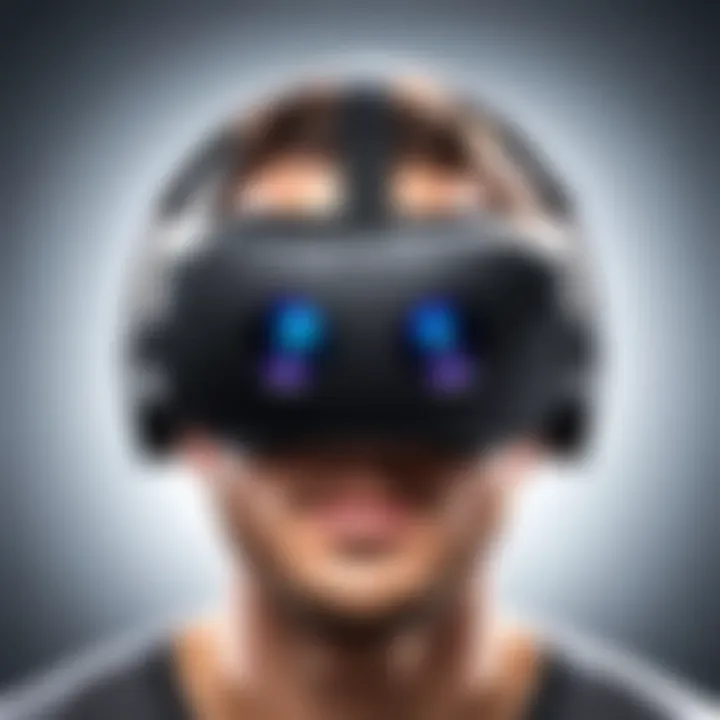
Intro
The rapid evolution of virtual reality technology has reshaped diverse sectors, including entertainment, education, and even healthcare. Among the platforms driving this transformation, Oculus Gear VR stands out. This system not only democratizes access to virtual reality experiences but also serves as a fertile ground for innovative applications. In this article, we provide a detailed analysis of Oculus Gear VR apps, focusing on their functionalities, performance, and user experiences.
Understanding the significance of these applications is paramount for IT professionals and tech enthusiasts. The insights gained through this exploration will guide informed technology-related decisions, especially for those tasked with developing or utilizing VR solutions.
As we navigate through the intricacies of the Oculus ecosystem, we will highlight key features of the apps available, assess their technical specifications, and analyze performance benchmarks that help determine their effectiveness in real-world scenarios. The discussion does not end there; we will also explore emerging trends and best practices in app development, setting the stage for future advancements in VR technology.
Let’s begin by examining the product overview of Oculus Gear VR applications, detailing key features and technical specifications that highlight their capabilities.
Intro to Oculus Gear VR
The realm of virtual reality has increasingly captured the interest of tech enthusiasts and IT professionals. With its immersive experiences and innovative applications, Oculus Gear VR stands out. This section aims to lay the foundational understanding of what Oculus Gear VR entails, its importance in the larger landscape of virtual reality, and the implications it has for users. The introduction will also highlight specific benefits and key considerations.
Overview of Virtual Reality
Virtual reality (VR) is a simulated experience that can resemble or differ from the real world. It enables users to engage with a three-dimensional environment created by computer technology. The essence of VR lies in its ability to transport users into environments where they can interact with both the virtual surroundings and objects. This leap in technology offers enhanced sensory engagement that traditional media cannot achieve.
The applications of virtual reality are vast. They span various sectors, including gaming, education, healthcare, and training simulations. As IT professionals and tech enthusiasts delve deeper into this digital frontier, understanding the nuances of virtual environments, user interactions, and content development become crucial. It is in this context that Oculus Gear VR presents itself as a pivotal player in the VR ecosystem.
The Role of Oculus Gear VR
Oculus Gear VR, developed in collaboration with Samsung, marks a significant advance in how users experience virtual environments. Unlike standalone VR systems, Oculus Gear VR operates as a mobile headset, leveraging smartphones to render content. This innovative design paves the way for more accessible VR experiences.
The role of Oculus Gear VR extends beyond mere entertainment. It serves as a platform for educational and productivity applications as well. Users can immerse themselves in virtual classrooms, simulation environments, or even remote workplaces. This versatility demonstrates Oculus Gear VR's potential to reshape how people learn, work, and entertain themselves.
Key considerations include user experience, app accessibility, and the technology’s limitations. The balance of performance and ease of use is vital as the ecosystem evolves. Developers must prioritize these factors to foster more profound engagement and usability for diverse audiences, including those less familiar with technology.
"Oculus Gear VR is not just a device. It represents a shift towards a more integrated virtual future, where boundaries between digital and physical worlds blur."
In summary, understanding Oculus Gear VR's position within the broader context of virtual reality is paramount. This knowledge equips IT professionals and tech enthusiasts with the insight to explore its existing applications and potential future developments.
Understanding Oculus Gear VR Apps
Understanding the landscape of Oculus Gear VR apps is critical in evaluating their role in the virtual reality ecosystem. These applications provide immersive experiences that captivate users in ways traditional software cannot. The variety within these apps showcases the versatility of the Oculus Gear VR, distributing its utility across gaming, education, and productivity. Each category of app has unique characteristics that cater to specific needs and preferences.
Types of Oculus Gear VR Apps
Gaming Applications
Gaming applications stand out as a prominent facet of Oculus Gear VR. They leverage the immersive capabilities of VR to create experiences that transport users into New worlds. The most compelling aspect of gaming on this platform is its ability to produce an engaging environment where players feel physically present.
One key characteristic of gaming applications is their interactivity. Users can engage in gameplay that requires movement and decision-making in a virtual space, enhancing the overall excitement. This quality makes gaming applications a beneficial choice for demonstrating the potential of VR technology in providing entertainment.
A unique feature of many gaming apps is their social integration, allowing users to play with others in real-time. This can foster a sense of community and competitiveness. However, some disadvantages include the need for substantial hardware requirements and potential motion sickness in certain users.
Educational Experiences
Educational experiences harness the power of VR to transcend traditional learning methods. They offer immersive simulations that can deepen understanding of complex topics. The ability of educational apps to place users in environments conducive to learning enhances retention of information.
A notable characteristic of educational experiences is their versatility. They can cover a vast range of subjects, from historical recreations to scientific explorations, making them appealing. This aspect positions them as a popular resource for educators and learners alike.
One distinctive feature of educational apps is the incorporation of interactive elements, such as quizzes and exploration challenges, which can enhance engagement. However, a potential drawback is the initial learning curve associated with using the technology, which may deter some users.
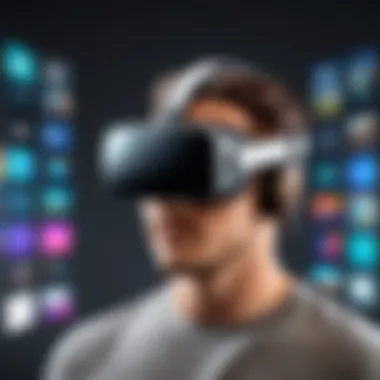
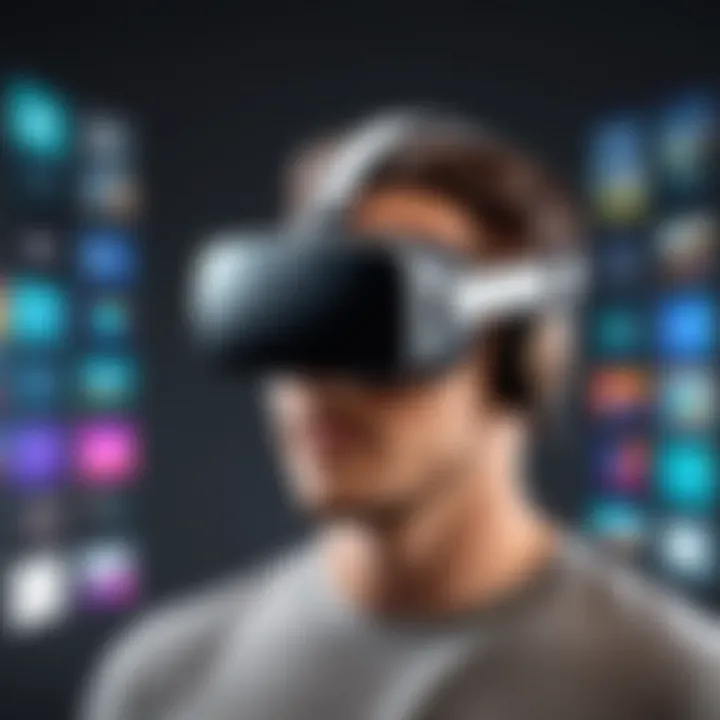
Productivity Tools
Productivity tools within the Oculus Gear VR ecosystem aim to improve users’ efficiency in various tasks. These applications often transform how professionals approach routine office work or project management. The core contribution these tools make is the ability to create a focused, distraction-free environment that can result in better concentration on tasks.
A defining characteristic of productivity tools is their ability to integrate with common office software, allowing users to work within their familiar interfaces. This functionality makes them a beneficial choice for professionals looking to optimize their workflows.
A unique aspect of these apps includes the capability for virtual collaboration, enabling teams to work together in a virtual space regardless of physical location. Still, some challenges exist, such as limited app availability and the requirement of a consistent internet connection for full functionality.
User Interface Considerations
When it comes to the Oculus Gear VR apps, user interface considerations are paramount. A well-designed interface can dramatically improve user experiences by facilitating easy navigation and interaction. Developers must focus on creating intuitive designs that cater to both seasoned VR users and novices alike.
Clear visual hierarchies, responsive controls, and satisfying feedback mechanisms are essential components that facilitate smooth interaction. Additionally, accessibility features, such as voice commands, can enhance usability for a broader range of users.
In summary, understanding these elements of Oculus Gear VR apps allows users and developers to leverage the technology more effectively, leading to richer experiences in virtual reality.
Key Features of Oculus Gear VR Apps
Understanding the key features of Oculus Gear VR apps is paramount for both developers and end-users. These features not only dictate the usability but also greatly influence user satisfaction and engagement. The appeal of these apps stems from their ability to create unique experiences that leverage the capabilities of virtual reality. Key features include immersive experiences, interactivity, and social integration, all of which shape how users interact with the applications and the value they derive from them.
Immersive Experience
The immersive experience stands at the forefront of Oculus Gear VR apps. It refers to the extent to which these apps can transport users into a different environment. Through advanced graphics and sound design, users feel present in virtual worlds. Elements such as 360-degree views, spatial audio, and haptic feedback enhance this experience. As a result, users can engage with the apps in more profound ways, leading to higher emotional and psychological engagement.
In the context of gaming, an immersive experience can turn simple gameplay into a thrilling adventure. Users often report feelings of presence, which enhances enjoyment and increases the likelihood of prolonged use. In educational settings, immersion is equally important. Studying historical sites or complex scientific phenomena through VR can foster deeper understanding and retention. It's crucial to note that the effectiveness of an immersive experience is often tied to the hardware's capabilities.
Interactivity and Engagement
Interactivity is another critical feature of Oculus Gear VR apps. It allows users to actively participate rather than just consume content. Interactive elements can range from simple point-and-click mechanics to complex simulations that require problem-solving and decision-making. By providing users with control, apps can significantly increase engagement levels.
One example of successful interactivity is evident in gaming applications. Users often enjoy building, exploring, and manipulating their environments, creating a sense of agency. In educational apps, users may engage in role-playing simulations that demand critical thinking and decision-making, making learning enjoyable and impactful. Developers must focus on intuitive controls and responsive interactions to ensure a fluid experience that does not disrupt user immersion.
Social Integration
Social integration within Oculus Gear VR apps enhances the user experience by fostering connections between users. This feature is increasingly relevant as social aspects of gaming and learning become more prominent. Apps that facilitate social interactions can empower users to share experiences, collaborate, and compete with others in real time.
Examples of social integration can be seen in multiplayer gaming environments and shared educational experiences. Users may join friends in virtual worlds, clean their social interactions more meaningful. The ability to form communities enhances the sustainability of apps, as users are more likely to return in search of social interaction along with their primary purpose of entertainment or learning.
"Social integration is not just a feature; it becomes a vital component of the user experience, bridging the gap between solitary and shared engagement."
App Development for Oculus Gear VR
The app development for Oculus Gear VR is a crucial part of understanding the ecosystem of virtual reality. As VR technology matures, developers must create applications that not only utilize the advanced capabilities of the hardware but also meet user expectations. This section will explore the tools, best practices, and challenges involved in creating Oculus Gear VR apps, emphasizing the importance of high-quality development for a positive user experience.
Development Tools and Platforms
Choosing the right tools and platforms is essential for effective app development. Many developers turn to Unity and Unreal Engine for creating immersive experiences. These engines offer robust frameworks that allow for rich graphics and interactivity. Unity, with its user-friendly interface, enables rapid prototyping which is useful for testing new ideas quickly.
On the other hand, Unreal Engine is preferred for its photorealistic capabilities. Developers should consider the following tools when working with Oculus Gear VR:
- Oculus SDK: Provides necessary libraries and APIs to enhance the app functionality.
- VRTK: A toolkit designed for VR development that simplifies interactions and movement.
- Blender: For 3D modeling and animation, creating assets for the VR world can be done effectively here.
Utilizing these tools allows developers to create engaging content while minimizing development time.
Best Practices in App Creation
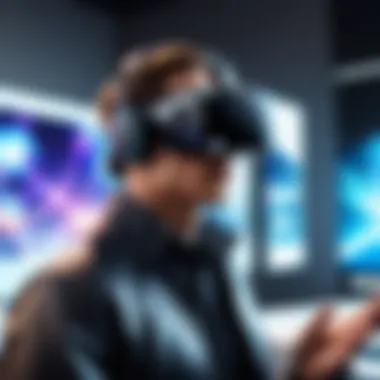
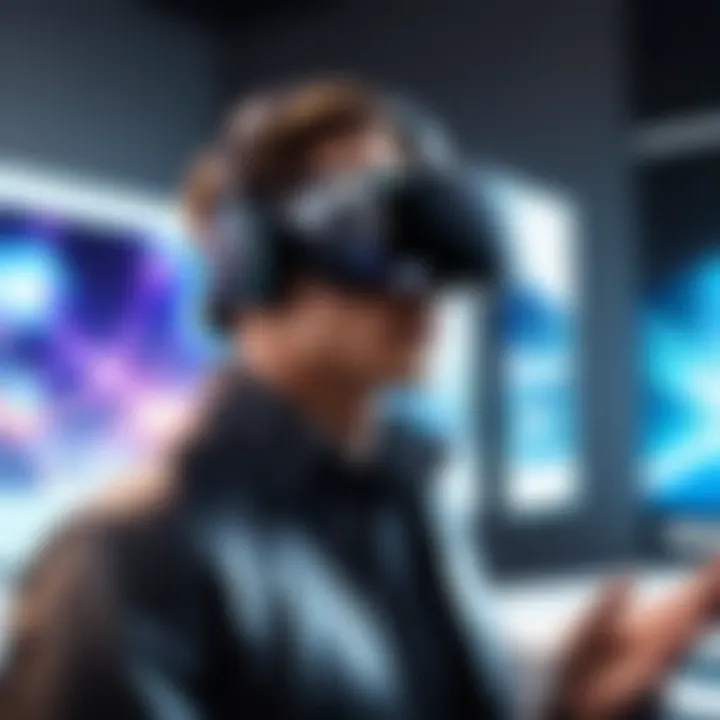
To deliver high-quality Oculus Gear VR apps, developers should adhere to certain best practices. These guidelines help ensure that the applications are not only functional but also enjoyable for the users. Some of the essential practices include:
- User-Centered Design: Focus on the user's experience by designing intuitive interfaces and ensuring ease of use.
- Performance Optimization: Maintain smooth frame rates to prevent motion sickness. Performance should be regularly tested across various devices.
- Testing and Feedback: Frequent interviews with target users during development phases can lead to valuable insights for improvements.
- Accessibility Features: Consideration of varying user capabilities should guide design decisions.
These best practices foster a development environment that values quality, ultimately leading to enhanced user satisfaction.
Challenges Faced by Developers
Despite the advancements in VR technology, developers encounter a range of challenges. Recognizing these issues early can help facilitate a smoother development process. Common challenges include:
- Hardware Limitations: Developing for a specific hardware like Gear VR often comes with constraints. Understanding these limitations is crucial before initiating development.
- Fragmentation: The variety of devices means apps must be optimized for different hardware configurations, which can be tedious and time-consuming.
- Navigating Market Competition: As VR apps gain popularity, standing out in a crowded market becomes crucial. Unique features and experiences will determine an app's success.
"The future of VR hinges not just on the technology but on creating meaningful user experiences, which begins with thoughtful app development."
Overall, tackling these challenges through strategic planning and innovative thinking will inspire successful Oculus Gear VR development.
Evaluation of Popular Oculus Gear VR Apps
The evaluation of popular Oculus Gear VR apps is vital in understanding the diverse ecosystem that this platform offers. With a variety of applications at users' disposal, assessing these apps helps readers identify which ones provide unique experiences and fulfill particular needs. This section will analyze gaming, educational, and productivity apps, highlighting key elements that make these tools essential for today’s tech-centric lifestyle.
Top Gaming Apps
Gaming apps on Oculus Gear VR stand out due to their immersive qualities and innovative gameplay mechanics. These apps are designed to leverage the VR technology to its full potential, enhancing user engagement and providing unique experiences.
Key titles such as "Beat Saber" and "Superhot VR" have garnered attention for their interactive elements and captivating gameplay. Users appreciate the physical involvement that VR games offer compared to traditional gaming formats. Also, the multiplayer capabilities in many of these titles foster community interaction, providing both entertainment and socialization.
Benefits of these gaming apps include:
- Immersion: The 3D sound effects and visual experiences transport users to different worlds.
- Physical Activity: Many games require movement, making them a fun way to exercise.
- Social Features: Cooperative gameplay encourages players to engage with friends.
Leading Educational Apps
The educational sector within Oculus Gear VR apps is rapidly growing. These applications harness VR technology to deliver unconventional learning experiences that traditional methods cannot replicate. Educational apps such as "Tilt Brush" allow users to paint in a 3D space, while apps like "The Body VR" offer immersive insights into human anatomy.
These applications provide numerous advantages:
- Enhanced Understanding: Complex concepts are easier to grasp through visually stimulating environments.
- Engagement: Interactive learning keeps students attentive and encourages exploration.
- Accessibility: Users can access a wide range of subjects from anywhere, democratizing education.
Innovative Productivity Apps
Productivity apps for Oculus Gear VR are transforming how professionals conduct their work. Tools such as "Spatial" and "vSpatial" facilitate collaboration in virtual spaces, allowing people to meet and share ideas without the restraints of physical location.
Such applications are crucial for:
- Team Collaboration: Virtual meeting spaces can enhance communication and creativity.
- Design and Prototyping: Apps that focus on visualization help in creating and altering designs effectively.
- Focus and Concentration: Users can personalize their virtual environment, reducing distractions from the physical world.
"The future of productivity software lies in immersive environments, where remote teams can collaborate more effectively than ever before."
The exploration of these categories of Oculus Gear VR apps provides a comprehensive understanding of their offerings. By evaluating the top gaming, educational, and productivity applications, readers gain insight into how these tools can enhance their lives in various dimensions.
User Experiences and Feedback
User experiences play a crucial role in the evolution of applications designed for the Oculus Gear VR platform. Understanding how users interact with VR apps enables developers to create more engaging and user-friendly offerings. The feedback collected from users serves as a vital resource that can inform updates, feature enhancements, and overall app design.


The importance of user experiences transcends mere satisfaction levels. It provides a clear insight into the practicality and accessibility of the apps. Users can highlight problems in functionality that developers may overlook, offering a real-world perspective that is often missed during the development phase. Moreover, analyzing feedback can help identify trends in usage, enabling adjustments that align with the wants and needs of the user base. This alignment may lead to increased user retention and a more significant overall impact in the VR sector.
Surveys and Research Insights
Surveys are an excellent way to gather data about user experiences with Oculus Gear VR applications. They can highlight general trends, pinpoint feature requests, and unveil pain points in existing apps. For example, surveys might ask users to rate aspects like usability, graphic quality, and content variety. Responses can be quantified and analyzed to derive actionable insights.
Research has shown that users prioritize immersion and interactivity in VR applications. According to a recent survey, 87% of users stated that engaging content significantly enhances their VR experience. Furthermore, distributed surveys across various demographics reveal diverse preferences, indicating that customization options can cater to a broader audience. Developers can utilize these insights to adapt their applications, enhancing satisfaction and engagement amongst users.
Case Studies of User Interactions
Analyzing specific case studies provides a more profound understanding of user interactions with Oculus Gear VR applications. One notable example is the app Rec Room, popular among social VR enthusiasts. Users often note that the ability to create and share rooms enhances community interaction, resulting in a dynamic user experience.
In another case, the app Tilt Brush received feedback regarding its creative capabilities. Users expressed appreciation for the intuitive interface, which allows for organic interaction with the art medium. However, some feedback also pointed out areas for improvement, such as additional options for collaboration and sharing creations.
"User feedback is not just comments; it's a roadmap to improving experiences in VR. Developers who listen can transform their products and retain user loyalty."
These case studies illustrate that analyzing the specific elements of user interactions leads to substantial improvements in app functionality. The continuous refinement driven by user feedback creates a cycle of enhancement, ensuring that applications remain relevant and enjoyable for the target audience. Through rigorous analysis and responsiveness to user experiences, developers can harness the collective intelligence of users to build superior applications.
Future Trends in Oculus Gear VR Apps
Understanding future trends in Oculus Gear VR applications is vital for several reasons. It helps stakeholders, including developers, users, and IT professionals, prepare and adapt to the evolving landscape of virtual reality. As technology advances, the functionalities and the overall experience of VR apps improve. This section elaborates on key advancements and their implications for the industry.
Advancements in Technology
Recent technological advancements play a crucial role in shaping the landscape of Oculus Gear VR apps. One significant trend is the integration of artificial intelligence into the VR experience. AI can enhance user interactions within apps, making them more intuitive and personalized. For instance, AI-driven environments can adjust based on user behavior, providing a tailored experience.
Another important advancement is the evolution of hardware. Devices like the Oculus Quest have made VR more accessible. Improved graphics and processing power lead to a richer visual experience. These enhancements not only elevate gaming but also educational and productivity applications.
In parallel, there is a growing emphasis on developing cross-platform compatibility. Users expect to engage with applications that seamlessly transition from VR to other devices, such as mobile phones or desktops. This adaptability enhances the usability of VR apps, attracting a broader audience.
Potential Industry Impact
The implications of these technological advancements stretch across various industries. In gaming, the predictive analytics enabled by AI can provide developers insights into user preferences. This data can inform future developments, ensuring that new games align closely with what players desire.
In education, VR apps now facilitate immersive learning experiences. Future trends indicate a higher adoption rate among institutions looking to enhance engagement in subjects ranging from science to history. The ability to simulate real-world scenarios gives students practical experience, fostering deeper understanding.
The productivity sector is also witnessing a transformation. As companies integrate VR tools for training and remote collaboration, the efficiency of teams is expected to increase. Being in a virtual environment allows for enhanced communication and problem-solving capabilities, reshaping team dynamics.
"The future of Oculus Gear VR apps is not just about entertainment; it’s about reshaping how we learn, collaborate, and experience the world around us."
Overall, as these trends continue to develop, they will play a significant role in influencing user expectations and shaping the future of Oculus Gear VR applications. Organizations and developers who recognize and adapt to these changes will likely gain a competitive edge in the rapidly evolving VR market.
Closure
The exploration of Oculus Gear VR apps has illuminated various facets of virtual reality applications. This analysis serves as a vital resource for understanding both the present state and the future potential of these tools in professional and personal contexts. As we have seen, Oculus Gear VR apps not only enhance entertainment but also offer robust educational and productivity options that can reshape the way we engage with technology.
Summary of Findings
Throughout the article, we have reviewed multiple aspects of Oculus Gear VR applications, ranging from their types to user experiences. Notable findings include:
- The diverse nature of app categories, covering gaming, education, and productivity, indicates a broad user base and extensive application.
- User interfaces have been designed with engagement in mind, ensuring a smooth transition into immersive experiences.
- The interactivity of these applications significantly increases user satisfaction, making the experience not just a passive one but one where users actively participate.
- Insights gathered from user feedback highlight the importance of continuous improvement in app development, stressing the need for responsiveness to user needs.
This summary encapsulates key points that underline the significance of Oculus Gear VR apps in both current and future technological landscapes.
Final Thoughts and Recommendations
In wrapping up this discussion, it is crucial for both developers and users to keep an eye on emerging trends within Oculus Gear VR applications. As technology continues to evolve, embracing innovative advancements can lead to improved user experiences and broader acceptance of virtual reality in various sectors.
For tech enthusiasts and IT professionals, the recommendation is to actively explore different applications and stay updated with the latest developments. Adopting a proactive approach will not only enhance personal experiences but also inform better decision-making in the professional realm.
Investing time in mastering these applications can open doors to new opportunities, making it essential to engage with the community through platforms such as reddit.com, where discussions around VR can enrich understanding and usage of Oculus Gear VR apps.



